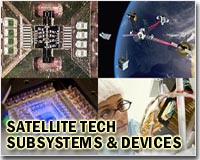 |
Bonn, Germany (SPX) Jul 19, 2010 On its launch date, 21 June 2010, roughly 16,000 kilometres separated TanDEM-X from its twin satellite, TerraSAR-X. Now, that distance has shrunk to just 2000 kilometres. The time has come for the relative movement between the two satellites to be slowed down, and for them to be set up for formation flying. To accomplish this, the Flight Dynamics Group at the German Space Operations Center (GSOC) will carry out a total of 10 orbital manoeuvres over the next eight days. The orbit of TanDEM-X was set shortly after its launch to an altitude some 4.6 kilometres lower than that of TerraSAR-X, meaning that TanDEM-X has a slightly higher orbital speed. This means that the two satellites have been approaching one another at a rate of approximately 630 kilometres per day - not much, when you consider that they are flying at a speed of 27,000 kilometres per hour. Without alterations to its orbit, TanDEM-X will overtake its twin within the next three days. However, the radar instrument team wants to achieve a large-separation formation; one in which TanDEM-X follows TerraSAR-X at a distance of 20 kilometres, covering the same track across the surface of the Earth. This formation will be retained until September, to allow the radar to be calibrated. Setting up the formation must take place in stages. On the one hand, the satellite only has four one-newton propulsion units - which equates to the force of four bars of chocolate on a set of kitchen scales. Given that it weighs in excess of 1300 kilograms, it follows that these propulsion units have to operate for a long time to effect small changes in speed. The manoeuvre, for example, will last for 421 seconds, and will alter the orbital speed by 1.14 metres per second. That might not sound like much, but it is enough to raise the mean orbit altitude by 2000 metres. A longer manoeuvre would have a negative impact on the effectiveness of the orbital correction. On the other hand, it is necessary to eliminate any risk of the two satellites colliding with one another. To accomplish this, the relative speed will be reduced in small steps. This means that by 18 July the satellites will only be approaching one another at the rate of about 140 kilometres each day. In the event that it proves impossible to carry out the final deceleration manoeuvre on 18 July, as a consequence of problems on the ground or on the satellite, the two satellites would move past one another at a safe distance of more than 250 metres. After this deceleration process, a further five manoeuvres are envisaged to precisely adjust the orbit's plane and ellipsoidal shape. If everything runs on schedule, it should be possible to start the next calibration phase for the radar instrument on 22 July.
Share This Article With Planet Earth
Related Links German Space Operations Center (GSOC) Space Technology News - Applications and Research
 Solar storm created 'zombie' satellite
Solar storm created 'zombie' satelliteWashington (UPI) Jul 13, 2010 U.S. scientists say they've identified a massive solar storm that reached Earth and caused a satellite to malfunction, turning it into a "zombie satellite." A NASA sun-watching spacecraft observed the explosion of plasma and magnetic energy, called a coronal mass ejection, on April 3, SPACE.com reported Tuesday. Charged particles in the solar storm disabled the Galaxy 15 communic ... read more |
|
| The content herein, unless otherwise known to be public domain, are Copyright 1995-2010 - SpaceDaily. AFP and UPI Wire Stories are copyright Agence France-Presse and United Press International. ESA Portal Reports are copyright European Space Agency. All NASA sourced material is public domain. Additional copyrights may apply in whole or part to other bona fide parties. Advertising does not imply endorsement,agreement or approval of any opinions, statements or information provided by SpaceDaily on any Web page published or hosted by SpaceDaily. Privacy Statement |